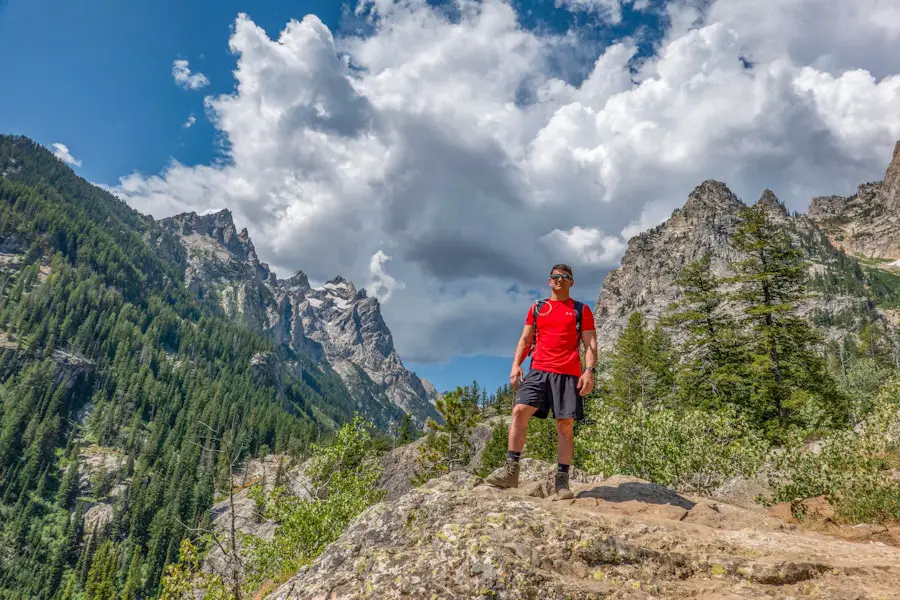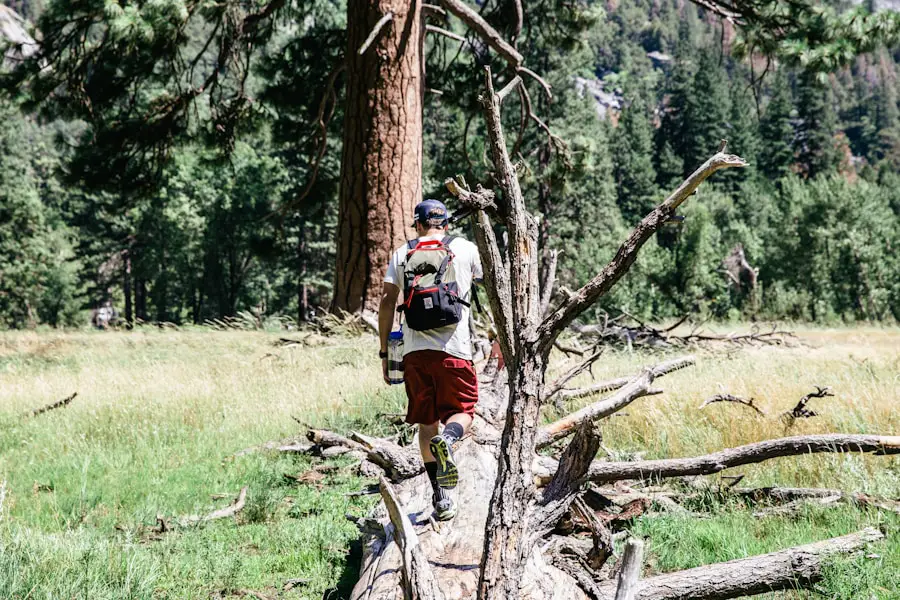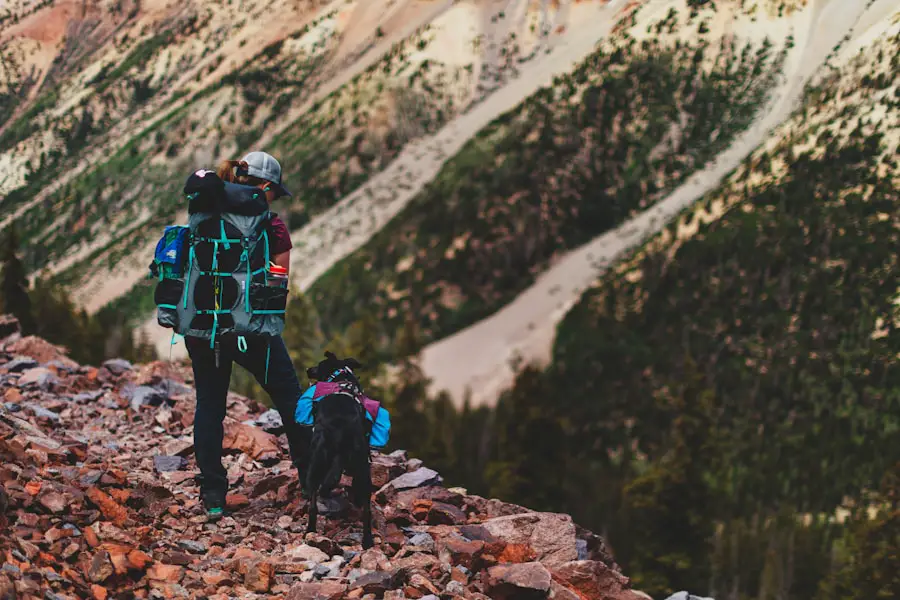Footwear is one of the most critical components of any outdoor adventure, particularly when it comes to hiking or camping. The right pair of shoes can make the difference between a comfortable trek and a painful ordeal. Hiking boots, for instance, are designed to provide support, traction, and protection against the elements.
They typically feature a sturdy sole that grips uneven terrain, preventing slips and falls. Additionally, many hiking boots come with waterproof materials to keep your feet dry in wet conditions, which is essential for maintaining comfort and preventing blisters. When selecting footwear, it’s important to consider the type of terrain you will encounter.
For rocky trails, a boot with a reinforced toe cap can protect your feet from sharp stones. Conversely, if you plan to hike in warmer climates, lightweight trail runners may be more appropriate, offering breathability and flexibility. It’s also advisable to break in new footwear before embarking on a long hike; this helps to avoid discomfort and blisters that can arise from wearing stiff, untested shoes over extended periods.
Key Takeaways
- Choose lightweight and durable footwear suitable for the terrain
- Layer clothing for versatility and pack a waterproof outer layer
- Carry a map, compass, or GPS device for navigation
- Wear a wide-brimmed hat and apply sunscreen regularly
- Pack a water filtration system and carry enough water for the trip
- Include a first aid kit, emergency blanket, and whistle in your supplies
- Select a backpack with adjustable straps and ample storage
- Bring a tent, sleeping bag, and cooking equipment for camping
Clothing
The clothing you choose for outdoor activities plays a pivotal role in your overall comfort and safety. Layering is a fundamental principle in outdoor apparel, allowing you to adapt to changing weather conditions. The base layer should be moisture-wicking to keep sweat away from your skin, while the mid-layer provides insulation to retain body heat.
Fleece jackets or thermal tops are popular choices for this layer, as they offer warmth without excessive bulk. The outer layer, or shell, should be waterproof and windproof to shield you from rain and cold winds. In addition to layering, it’s essential to consider the materials used in your clothing.
Synthetic fabrics like polyester and nylon are often favored for their quick-drying properties and durability. Merino wool is another excellent option; it regulates temperature well and remains odor-free even after prolonged wear. When selecting clothing for outdoor activities, pay attention to fit as well.
Loose-fitting garments can snag on branches or equipment, while overly tight clothing can restrict movement and circulation.
Navigation tools

Navigating through the wilderness requires reliable tools that can guide you safely to your destination. Traditional maps and compasses remain invaluable resources for outdoor enthusiasts. A topographic map provides detailed information about the terrain, including elevation changes and natural landmarks.
Learning how to read these maps is crucial; understanding contour lines and symbols can help you make informed decisions about your route. In addition to maps and compasses, modern technology has introduced GPS devices and smartphone applications that can enhance navigation capabilities. GPS units are particularly useful for tracking your location in real-time, allowing you to navigate unfamiliar areas with confidence.
However, reliance on technology can be risky; battery life can be an issue in remote areas, and signal loss may occur in dense forests or mountainous regions. Therefore, it’s wise to carry both traditional navigation tools and electronic devices to ensure redundancy in case one fails.
Sun protection
| Country | Percentage of Population Using Sunscreen | Percentage of Population Using Hats |
|---|---|---|
| United States | 30% | 45% |
| Australia | 55% | 60% |
| United Kingdom | 25% | 35% |
Sun protection is an often-overlooked aspect of outdoor preparation but is vital for maintaining skin health during prolonged exposure to sunlight. Ultraviolet (UV) radiation can cause sunburn, premature aging, and increase the risk of skin cancer. To combat these effects, broad-spectrum sunscreen with an SPF of at least 30 should be applied generously to all exposed skin.
It’s important to reapply sunscreen every two hours or immediately after swimming or sweating. In addition to sunscreen, protective clothing can significantly reduce UV exposure. Long-sleeved shirts made from lightweight, breathable fabrics can shield your arms while keeping you cool.
Wide-brimmed hats are also effective at protecting your face and neck from direct sunlight. Sunglasses with UV protection are essential for safeguarding your eyes from harmful rays that can lead to cataracts and other vision problems. By combining these protective measures, you can enjoy your outdoor activities while minimizing the risks associated with sun exposure.
Water and hydration
Staying hydrated is crucial during any outdoor activity, especially in hot or dry conditions where fluid loss can occur rapidly through sweat. Carrying an adequate supply of water is essential; the general recommendation is to drink at least half a liter of water per hour during moderate activity. However, this amount may vary based on individual needs, temperature, and exertion levels.
It’s wise to plan your water sources ahead of time—whether that means filling up at streams or lakes or carrying enough bottled water for your entire trip. In addition to water, electrolyte replenishment is important during strenuous activities. Electrolyte drinks or tablets can help replace lost minerals such as sodium and potassium that are essential for muscle function and overall hydration balance.
Some outdoor enthusiasts prefer hydration packs that allow for easy sipping while on the move; these packs often come with a reservoir that holds several liters of water and a tube for convenient access. Regardless of your method of hydration, ensuring that you have enough water is paramount for both performance and safety during outdoor excursions.
Emergency supplies

No outdoor adventure is complete without a well-thought-out emergency supply kit. Accidents can happen at any time, so being prepared can mean the difference between a minor inconvenience and a serious situation. A basic emergency kit should include items such as a first aid kit stocked with bandages, antiseptic wipes, pain relievers, and any personal medications you may need.
Additionally, a multi-tool or knife can be invaluable for various tasks ranging from food preparation to gear repairs. Other essential items include a whistle for signaling help, a flashlight with extra batteries for visibility after dark, and a fire-starting kit for warmth or cooking in emergencies. It’s also wise to carry an emergency blanket or bivy sack that provides insulation against cold temperatures if you find yourself stranded overnight.
Regularly checking and updating your emergency supplies ensures that everything is functional and ready when needed.
Backpack
Choosing the right backpack is fundamental for carrying all your gear comfortably during outdoor activities. The size of the backpack should correspond with the length of your trip; day hikes typically require smaller packs ranging from 15 to 30 liters, while multi-day excursions may necessitate larger packs of 50 liters or more. A well-designed backpack distributes weight evenly across your body, reducing strain on your back and shoulders.
When selecting a backpack, consider features such as adjustable straps, padded hip belts, and ventilation systems that enhance comfort during long hikes. Compartments for organization are also beneficial; having designated pockets for water bottles, snacks, and gear allows for easy access without rummaging through the entire pack. Additionally, look for backpacks made from durable materials that can withstand the rigors of outdoor use while remaining lightweight enough for comfortable carrying.
Camping gear
Camping gear encompasses a wide range of equipment designed to enhance your outdoor experience while providing comfort and safety in nature. A quality tent is one of the most critical components; it should be weather-resistant and easy to set up while providing adequate space for occupants and gear storage. Tents come in various styles—some are designed for quick setups like pop-up tents, while others offer more durability for extended stays in harsh conditions.
Sleeping gear is equally important; sleeping bags rated for specific temperature ranges ensure warmth during chilly nights outdoors. Sleeping pads add an extra layer of comfort by cushioning against hard ground surfaces while also providing insulation from cold temperatures below. Cooking equipment such as portable stoves or campfires allows you to prepare meals in the wilderness; lightweight cookware made from materials like titanium or aluminum is ideal due to its durability and heat conductivity.
In addition to these essentials, consider bringing along items like portable chairs for relaxation around the campfire or hammocks for lounging during downtime. Each piece of camping gear contributes to creating a comfortable environment that allows you to fully enjoy the beauty of nature while minimizing discomforts associated with outdoor living.
If you’re planning a hiking trip in Colorado, you’ll want to make sure you’re dressed appropriately for the changing weather conditions. One helpful article to check out is Flying with a Big Dog: Tips for Traveling with Your Large Pup, which offers insights on how to prepare for travel with your furry companion. Just like packing for your dog, packing the right clothing and gear for your hike in Colorado is essential for a safe and enjoyable experience.
FAQs
What should I wear for hiking in Colorado?
When hiking in Colorado, it’s important to wear layers to accommodate for the changing weather conditions. Start with a moisture-wicking base layer, add a insulating layer, and finish with a waterproof and windproof outer layer.
What type of footwear is best for hiking in Colorado?
For hiking in Colorado, it’s recommended to wear sturdy, waterproof hiking boots with good ankle support. The terrain can be rocky and uneven, so having proper footwear is essential for a comfortable and safe hike.
What type of pants are suitable for hiking in Colorado?
When hiking in Colorado, it’s best to wear lightweight, quick-drying pants that provide protection from brush and insects. Convertible pants are also a good option as they can be converted into shorts if the weather gets warmer.
What kind of accessories should I bring for hiking in Colorado?
It’s important to bring a wide-brimmed hat, sunglasses, sunscreen, and a map or GPS device when hiking in Colorado. Additionally, packing a first aid kit, plenty of water, and high-energy snacks is essential for a safe and enjoyable hike.
Are there any specific clothing items to avoid when hiking in Colorado?
Avoid wearing cotton clothing when hiking in Colorado, as it retains moisture and can lead to discomfort and even hypothermia in changing weather conditions. Instead, opt for moisture-wicking and quick-drying fabrics to stay comfortable on the trail.
